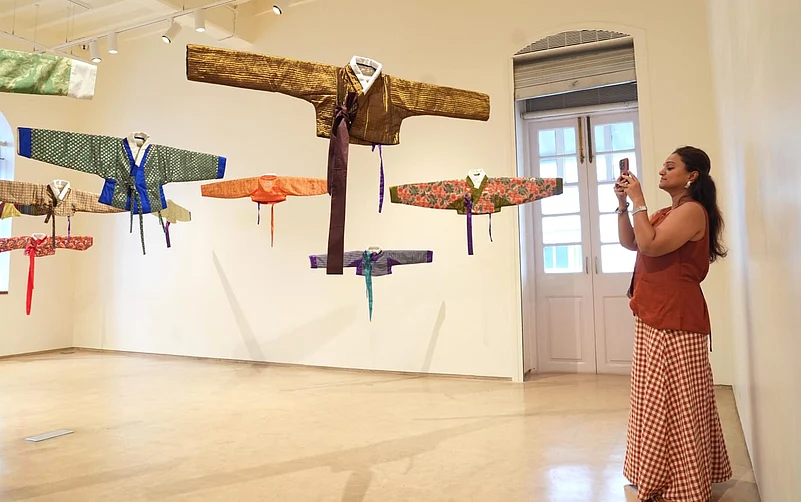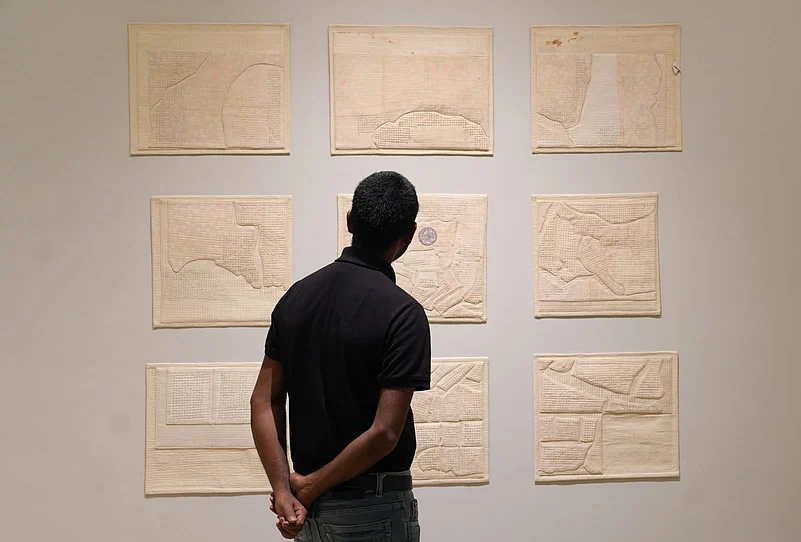Volume IV: Truths, Half-Truths, Half-Lies, Lies is an exhibition that unravels the subtle yet deeply political ways in which clothing continues to shape, contain, and communicate identity. Through fabric, form, and memory, Kolkata-based Kallol Datta maps how the everyday act of dressing is rarely neutral and is often entangled in structures of power, obedience, and resistance.
The conceptual seed for the exhibition was planted in 2022, within the hushed corridors of a university library in London. While researching, artist and curator Datta encountered Lessons for Women, a nearly 2,000-year-old text authored by Ban Zhao, the first recorded female historian in Chinese history. Written during the Han dynasty, the text takes the form of maternal advice, offering instruction on how women should conduct themselves: how to speak, move, bathe, clean, and crucially, how to dress. What appears at first as care quickly reveals itself as control, laying bare the long-standing role of clothing in codifying acceptable behaviour.
“Ban Zhao’s text, while ancient, wouldn’t seem out of place at a political rally or an op-ed today, in any part of the world. Researching on historical social codes, dress codes, and behavioural codes it was apparent how they have informed and influenced contemporary social norms and laws of the land,” Datta says.

Building on this provocation, Volume IV unfolds across four conceptual ‘truth-states’—Truths Our Clothes Told Us, Half-Truths Our Clothes Told Us, Half-Lies Our Clothes Told Us, and Lies Our Clothes Told Us.
Each chapter functions as both archive and inquiry, inviting viewers to examine how garments have historically functioned as both tools of expression and instruments of regulation. Clothing, here, is not just aesthetic, it becomes a record of cultural inheritance, social conditioning, and embodied defiance.
For Datta, this is part of a long-standing practice of thinking through textiles. Over the years, he has developed a quiet but powerful language of dress that sidesteps spectacle, resists the pull of trend cycles, and even challenges the word "fashion" itself. His works do not dwell in hypothetical realms—they are grounded in lived materiality. “Clothing edicts have never existed in a vacuum. The politics of the body have always been aligned with the constrictions of public and private lives experienced by gender and sexual minorities. Even today we see how an item of clothing and the codes around it impact access to education, personal safety, and approaches to employment. Basic human rights one would think,” Datta explains.

The fabrics used in Volume IV, which are donated, second-hand, and reclaimed, are chosen precisely because they arrive with histories embedded in their folds. They carry traces of previous wear, of use, of care, of invisibility.
All the works were produced in collaboration with Ek Tara Creates, a Kolkata-based social enterprise that supports women artisans. Here, slowness is not a delay but a deliberate methodology—a refusal to participate in fashion’s accelerating churn. Through these pieces, Datta cultivates a counter-rhythm, privileging process over product, memory over novelty.
Volume IV invites viewers to listen carefully to what our clothes might be saying—and just as crucially, what they’ve been made to silence. “The project and by extension the solo position themselves as a series of creative and critical interventions through living textile archives - navigating the public and the private, the historical and the contemporary. The division of the project into chapters allowed for a deliberate, reflective process of reimagining, unlearning, and challenging dominant histories,” he says.















